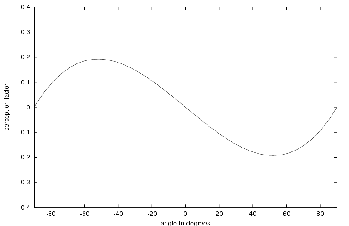 |
The corridor follower programmed is based on the vision of the flies described in [13]. The sensitivity of the vision is different for different area in the space. It is the same for humans. If we are looking in front of us, the perception of an object is less difficult if it is in front of us than next to us.
So the idea is to build a sensitivity function that acts as a filter and allows good features to be correctly perceived and bad features to be difficult to perceive. This function is shown in figure 3.9.
 |
The values computed for the histogram which corresponds to the angles of the Hough space are now multiplied by a perception factor. As we can see, angles near ![]() and
and ![]() are well detected. On the contrary, angles near
are well detected. On the contrary, angles near ![]() and
and ![]() are not detected at all. Indeed this sensitivity function has been designed to rest on diagonal lines in the image which correspond to strong edges of the ceiling. The sensitivity function changes its sign around
are not detected at all. Indeed this sensitivity function has been designed to rest on diagonal lines in the image which correspond to strong edges of the ceiling. The sensitivity function changes its sign around ![]() because if we detect a strong line at
because if we detect a strong line at ![]() , we want to turn right, but if we detect a line at
, we want to turn right, but if we detect a line at ![]() we want to turn left, that is we want to steer using a negative angle.
we want to turn left, that is we want to steer using a negative angle.
After applying this filter to the angle histogram of the Hough space, we simply sum the results to find the steering angle we have to use.
As we do not use the joystick anymore for the algorithm, the program can control the motors each time. So we can stop the robot for each processed frame. This avoid blur in the image, and also assure us that the computed steering angle will be used in a same position in the corridor as the inputs were taken.
During tests in a real corridor this algorithm performed very well providing that the robot was correctly positioned at the beginning of the test. If the robot is looking at a wall at the beginning, the robot cannot avoid it because it cannot detect it. But in normal use, the algorithm seemed to perform correctly enough to be used as a teacher for the automatic corridor learning.
A drawback that can be signalled is that if for one reason or another the landmark we used is hidden, the robot cannot choose the right steering angle. For instance, if someone is standing in front of the robot far enough not to be detected by the safety procedure and close enough to hide strong edges of the ceiling, then the robot is lost.